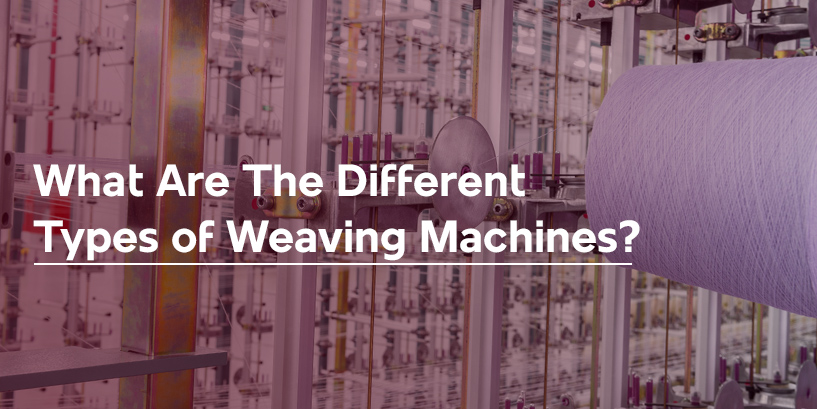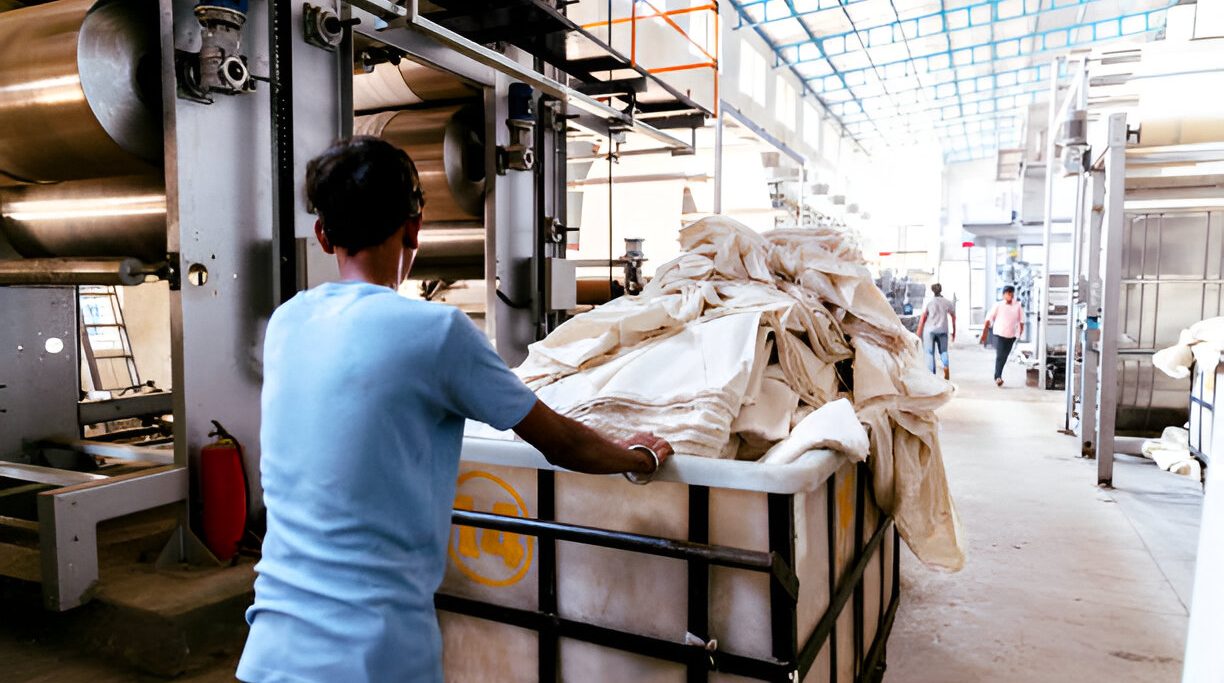Ever since John Kay’s invention of the flying shuttle in 1733, weaving has dominated the textile production market. It is an effective method that has continued to process raw materials like cotton yarns into objects with practical purposes. Although weaving was dependent on manual labour until the Industrial Revolution, weaving machinery continued to evolve with the emergence of new technologies. So, what are the different types of weaving machines?
Presently, there are several types of weaving machines dominating the textile market. However, primarily they are divided into three basic types- Shuttle, Circular and Narrow Fabric. Every weaving loom comes with a set of distinct features, but in their essence, all the different types of weaving machines perform the very task of holding threads taut lengthwise while the other threads are woven crosswise.
Besides, some of the most used looms include-
- Projectile Loom
- Ribbon Loom, etc.
As per research, the worldwide clothing industry is a predominant part of the global share market. In 2021, more than 73% of the global revenue share was generated directly from the fashion trade. Experts have noted that the worldwide population’s increased spending on apparel had contributed to this upswing. This surge in demand warrants a surge in the production rate. Various kinds of weaving machines are needed to ensure quality textile products are churned out in a wide variety.
This blog gives an in-depth look at the various kinds of weaving machines and how they continue to improve the textile market.
Shuttle Loom
Generally controlled via electronic means, this weaving machine is used to weave warp and weft patterns. The shuttle is a narrow piece of plastic or wood that contains a bobbin of filling yarn. It is batted across the loom back-and-forth to form interlacement to produce fabric.
Shuttle looms are comparatively low-cost than their counterparts, making textile production cost-effective. Consequently, these are used mainly to weave silk and other commercial linens in industrial operations. The machinery is also worker-friendly as it is easy to operate. Furthermore, the ready availability of the spare parts for shuttle looms ensures that the production process never comes to an abrupt halt.
Projectile Loom
A projectile loom is a shuttleless weaving machine. These machines have bullet-shaped metal devices called projectiles that have replaced the usage of a shuttle. Although the warp yarns are set into the loom here too, it uses the projectiles to grip onto the yarn and carry that through the weaving shed.
Projectile looms can produce different kinds of fashionable fabric. It can reduce the external noise when in motion and thus ensures a well-functioning working procedure. Furthermore, this device is energy-efficient, consuming approximately 3 Kilo-Watt/Hour.
Circular Loom
The shed for this loom is built around the machine. The equipment consists of several circulating shuttles which move around the periphery disseminating the weft. The primary concern of a circular loom is to produce tubular fabric. So it is used in creating seamless fabric products, such as clothing, fire hose, sacks, hosiery, etc. Moreover, the production of bagging materials required for composite lamination is highly dependent on the circular weaving machine. Modern circular looms also use electromagnets for the high-speed production of garments.
Ribbon Loom
A ribbon loom is a narrow fabric loom able to weave more than forty pieces together. These looms have jacquard fitted at the top of them, controlled by a stack of perforated cards. The jacquard machine helps the ribbon loom in processing complex patterns like brocade and matelassé, etc.
The interchangeable perforated cards have long been considered a significant step toward complete automation. For example, the loom uses these cards to remember and repeat weaving patterns using the binary system.
Rapier Loom
When it comes to rapier looms, a stationary package of yarn supplies the weft threads for the machine. Here finger-like carriers called rapiers are used to carry the filling yarn towards the other end. There are two different types of rapier looms in use-
- Single Rapier Loom Machine
- Double Rapier Loom Machine
One of the major plus points of these machines is their flexibility. This allows the rapier looms to have picks of different colours. Furthermore, this weaving equipment can also weave yarns of any type of fibre.
Water Jet Loom
As the name suggests, a water jet carries the filling yarn through the weaving shed for this kind of machine. The length of the weft yarn gets measured previously, and this loom functions at a high speed of 600 picks/minute.
The plus point of the water jet loom is that it places a minimum amount of pressure on the filling yarn. This ensures that the weaving machine operates systematically, without a hitch. Moreover, these are able to produce quality end products like aesthetically pleasing fabrics.
Air Jet Loom
The filling yarn is carried by a jet of air in this kind of weaving machine. The air jet loom can provide higher weft insertion performance while also being energy-saving. Moreover, the machine is used to produce high-quality fabrics concisely. The usage of uniform weft yarns ensures this high productivity rate.
Multiphase Loom
In a multiphase loom, continuous weft insertion is carried out by shuttles or weft carriers. As a result, this kind of weaving machine has a high speed and efficiency rate. Depending on the product variant, rotating spiked wheels or oscillating reeds are used in this loom to engineer the beating up process.
Additionally, the production cost of using a multiphase weaving machine is in lower numbers, making it a budget-friendly method. Notably, this equipment uses the multi-linear shed principle [M8300] to produce simple but standard quality fabric.
Needle Loom
In a needle loom, a long eye-pointed needle is used to carry the filling yarn through the shed. This weaving machine is generally used to produce nylon or polyester fabrics. The electromagnetic brake, lock thread weaving system and auto stop-motion of this machine guarantee a high-performance outcome.
Swivel Loom
These looms are used to interweave small decorative effects on a fabric’s surface while manufacturing. A row of small shuttles is used in these looms to ensure there is no shortage in the supply of the extra weft thread required for the interweaving. Because independent and singular shuttles are used to imprint the decorative figures, they can have their own different colours too.
Magazine Loom
A magazine loom is an automated mechanism in which the empty bobbin of a shuttle is replaced into it by a full one without stopping the shuttle. Depending on the variants, either one or four colours can be used in the warp of this weaving machine.
Box Loom
This weaving mechanism uses multiple shuttles to weave fabrics with an array of filling yarns. These looms have several shuttle dropboxes on one or both sides of the machine. As a result, they can swiftly interchange between two shuttles with bobbins of different colours, twists and sizes. Consequently, this machine makes the process of weaving multiple colours for figured fabric easier.
Different Types Of Weaving Machines – Are There Other Variants Too?
There are several other types of weaving machines currently in use, like
- Ground Looms
- Back Strap Looms
- Frame Looms
- Rigid Heddle Looms
- Haute Lisse And Basse Lisse Looms
CAD/CAM Technology
CAD/CAM stands for Computer-Aided Design/Computer-Aided Manufacturing. In recent times, global fashion discourse has been buzzing about implementing this technology in weaving machines. Because of its vast application area, this technology has been a game-changer in fashion design and manufacturing. For example, re-colouration, creating motifs or designing shapes becomes effectively simpler with different types of weaving machines integrated with the CAD/CAM system.
Frequently Asked Questions
How many sets of yarn are used in the weaving machine?
Two different sets are used, called warp and weft.
How many different kinds of weaving machine sheds are there?
There are four types of sheds-
- Bottom Close Shed
- Centre Close Shed
- Semi-Open Shed
- Open Shed
How many different types of shedding mechanisms are used in weaving machines?
Mainly five types of shedding mechanisms are used in weaving machines,
Paddle/Treadle Shedding
Tappet Shedding
Dobby Shedding
Jacquard Shedding
Combined Shedding
What are the primary motions of a weaving loom?
There are three primary motions- shedding, beating and picking.



